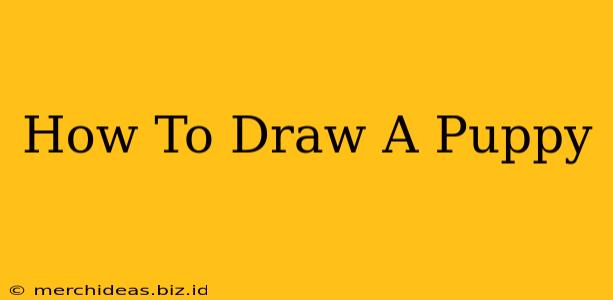Learning how to draw a puppy can be a fun and rewarding experience, regardless of your skill level. This guide provides a simple, step-by-step approach, perfect for beginners. We'll focus on capturing the essence of a puppy's adorable features, making it accessible and enjoyable for everyone.
Getting Started: Materials and Preparation
Before we begin our artistic journey, let's gather our materials. You'll need:
- Paper: Use drawing paper or a sketchbook. The heavier the paper weight, the better it will handle erasing and layering.
- Pencils: A range of pencils is beneficial. A #2 pencil is a good all-around choice, but having a harder pencil (like a 4H) for light sketching and a softer pencil (like a 2B or 4B) for shading is helpful.
- Eraser: A kneaded eraser is ideal, as it can be molded to reach small areas and lift pencil marks without damaging the paper.
- Sharpener: Keep your pencils sharp for clean lines and details.
Optional:
- Ruler: For initial sketching and proportions.
- Colored Pencils, Markers, or Paints: To add color and life to your puppy drawing once you're happy with your sketch.
Step-by-Step Puppy Drawing Tutorial
Let's start drawing! Follow these steps to create your own adorable puppy portrait.
Step 1: Basic Shapes
Begin by sketching basic shapes to form the foundation of your puppy's body. Think of a circle for the head, an oval for the body, and smaller circles or ovals for the legs. Don't worry about perfection at this stage; these are just guides.
Step 2: Defining the Head
Refine the head circle. Add a slightly smaller circle inside for the puppy's snout. Add two small circles for the eyes, positioned slightly below the top of the head.
Step 3: Adding Features
Sketch in the puppy's ears. Puppy ears vary widely – floppy, pointed, etc. Observe photos of puppies to find a style you like. Add a small triangle for the nose and curved lines for the mouth. Add small circles for the pupils within the eyes.
Step 4: Body and Legs
Using the oval you sketched for the body, refine its shape. Make it slightly curved to show the puppy's back. Use the small circles you sketched for the legs to create the legs, adding joints and paws.
Step 5: Tail and Details
Add the tail! Puppies have playful tails – make it wagging! Add details like fur texture using short, light strokes.
Step 6: Refining and Shading
Now, carefully erase the initial guide shapes. Use your eraser to lift any unwanted lines. Add shading to give your puppy dimension and depth. Consider where the light source is and shade accordingly. Use darker pencils for deeper shadows.
Step 7: Finishing Touches
This is where you can personalize your drawing. You can add details like spots, stripes, or other markings. Consider adding a collar or a cute toy.
Tips for Success
- Observe real puppies: Look at photos or even better, observe a real puppy! This will help you understand their proportions and features.
- Don't be afraid to erase: Drawing is a process. Use your eraser freely to adjust and refine your work.
- Practice makes perfect: The more you draw, the better you'll become. Don't get discouraged if your first attempt isn't perfect.
- Have fun! Drawing should be enjoyable. Relax, let your creativity flow, and enjoy the process of bringing your puppy to life on paper.
Beyond the Basics: Exploring Different Puppy Breeds
Once you've mastered the basics, try drawing different breeds of puppies! Each breed has unique features, making it a fun challenge to capture their individual characteristics. Research different breeds to find inspiration for your next drawing. Experiment with different styles and techniques, and most importantly – keep practicing! You'll be amazed at how your skills develop over time.
